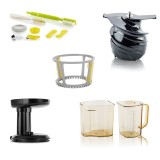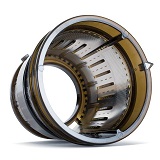Use of Fruits and Veggies
Sometimes our customers experience difficulties when squeezing celery.
What is noticeable are the long fibers of the celery that are clinging to the screw and get stuck in the pulp exit. This is a known issue. We have many customers who like to squeeze celery. (often because they are enthusiastic about celery juice after reading Anthony Willams' book).
The problem then often lies in feeding long pieces of celery in the hopper. There are no knife blades in the Versapers and the screw just presses and bruises the vegetables. Because celery has a lot of hard fibers, these fibers become just pieces of rope that turn around the screw and get stuck in the pulp exit because they can not get around the sharp corner of the pulp exit. This will cause the pulp to not exit properly and get clogged up above. The pressure in the strainer and the bowl thus increases. This situation goes from bad to worse, the pressure increases but the pulp must go somewhere at some point. Then it eventually goes under and over the strainer and you end up with a juice full of pulp.
The best way to make it easy for your machine is to cut these fibers 0.5 - 1 cm very short. The shorter you cut it, the easier it is for the machine to process. So if you have a stalk of celery, cut the bottom off, then remove the individual stalks. Rinse each stalk clean and then put them back together on a large cutting board. Then chop the celery with a large sharp knife into "macaroni curves". Rather more fine than too coarse, but do what you can and are comfortable with.
If you work this way, the pulp output will flow much better and your juice will be of better quality even if you juice 3 whole bunches of celery. The same advice applies to all fibrous vegetables, such as fennel, ginger, dill or parsley stems etc. etc.















